Evolutionary Inferences on the Chromosomal Diversity of Anseriformes (Neognathae; Galloanseres) by Microsatellite Mapping
Simple Summary
Abstract
1. Introduction
2. Materials and Methods
2.1. Cell Culture and Chromosome Preparations
2.2. Giemsa Staining
2.3. Fluorescence in Situ Hybridization-FISH
2.4. Microscopic Analysis and Image Processing
3. Results
3.1. Conventional Analysis
3.2. Microsatellite Mapping
4. Discussion
5. Conclusions
Author Contributions
Funding
Institutional Review Board Statement
Data Availability Statement
Acknowledgments
Conflicts of Interest
References
- Gill, F., 3rd; Donsker, D.; Rasmussen, P. IOC World Bird List (v14.2). Available online: https://www.worldbirdnames.org/new/ (accessed on 5 January 2025).
- Van Tuinen, M., 3rd; Hedges, S.B. Calibration of avian molecular clocks. Mol. Biol. Evol. 2001, 18, 206–213. [Google Scholar] [CrossRef] [PubMed]
- Sun, Z.; Pan, T.; Hu, C.; Sun, L.; Ding, H.; Wang, H.; Zhang, C.; Jin, H.; Chang, Q.; Kan, X.; et al. Rapid and recent diversification patterns in Anseriformes birds: Inferred from molecular phylogeny and diversification analyses. PLoS ONE 2017, 12, e0184529. [Google Scholar] [CrossRef] [PubMed]
- Spaulding, F.; McLaughlin, J.F.; Cheek, R.G.; McCracken, K.G.; Glenn, T.C.; Winker, K. Population genomics indicate three different modes of divergence and speciation with gene flow in the green-winged teal duck complex. Mol. Phylogenet. Evol. 2023, 182, 107733. [Google Scholar] [CrossRef]
- Zelenkov, N.V. The oldest Asian duck (Anseriformes: Romainvilla) and the origin of Anatidae. Dokl. Biol. Sci. 2018, 483, 225–227. [Google Scholar] [CrossRef] [PubMed]
- Musser, G.; Clarke, J.A. A new Paleogene fossil and a new dataset for waterfowl (Aves: Anseriformes) clarify phylogeny, ecological evolution, and avian evolution at the K-Pg Boundary. PLoS ONE 2024, 19, e0278737. [Google Scholar] [CrossRef]
- Houde, P.; Dickson, M.; Camarena, D. Basal Anseriformes from the Early Paleogene of North America and Europe. Diversity 2023, 15, 233. [Google Scholar] [CrossRef]
- Beklemisheva, V.R.; Tishakova, K.V.; Romanenko, S.A.; Andreushkova, D.A.; Yudkin, V.A.; Interesova, E.A.; Yang, F.; Ferguson-Smith, M.A.; Graphodatsky, A.S.; Proskuryakova, A. Detailed cytogenetic analysis of three duck species (the northern pintail, mallard, and common goldeneye) and karyotype evolution in the family Anatidae (Anseriformes, Aves). Vavilovskii Zhurnal Genet. Sel. 2024, 28, 759–769. [Google Scholar] [CrossRef]
- Abu-Almaaty, A.H.; Hassan, M.K.; El-Bakary, N.E.; Ahmed, S.H. Chromosomal evolution and molecular genetic analysis of four species of genus Anas (Aves: Anatidae). Genetika 2019, 51, 103–119. [Google Scholar] [CrossRef]
- Uno, Y.; Nishida, C.; Hata, A.; Ishishita, S.; Matsuda, Y. Molecular cytogenetic characterization of repetitive sequences comprising centromeric heterochromatin in three Anseriformes species. PLoS ONE 2019, 14, e0214028. [Google Scholar] [CrossRef]
- Islam, F.B.; Uno, Y.; Nunome, M.; Nishimura, O.; Tarui, H.; Agata, K.; Matsuda, Y. Comparison of the chromosome structures between the chicken and three anserid species, the domestic duck (Anas platyrhynchos), Muscovy duck (Cairina moschata), and Chinese goose (Anser cygnoides), and the delineation of their karyotype evolution by comparative chromosome mapping. J. Poult. Sci. 2014, 51, 1–13. [Google Scholar]
- Rodrigues, B.S.; Assis, M.D.F.L.; O’Brien, P.C.; Ferguson-Smith, M.A.; Oliveira, E.H. Chromosomal studies on Coscoroba coscoroba (Aves: Anseriformes) reinforce the Coscoroba–Cereopsis clade. Biol. J. Linn. Soc. 2014, 111, 274–279. [Google Scholar] [CrossRef]
- Ebied, A.M.; Hassan, H.A.; Almaaty, A.H.A.; Yaseen, A.E. Karyotypic Characterization of Ten Species of Birds. Cytologia 2005, 70, 181–194. [Google Scholar] [CrossRef]
- Degrandi, T.M.; Barcellos, S.A.; Costa, A.L.; Garnero, A.D.V.; Hass, I.; Gunski, R.J. Introducing the Bird Chromosome Database: An Overview of Cytogenetic Studies in Birds. Cytogenet. Genome Res. 2020, 160, 199–205. [Google Scholar] [CrossRef]
- López-Flores, I.; Garrido-Ramos, M.A. The repetitive DNA content of eukaryotic genomes. Genome Dyn. 2012, 7, 1–28. [Google Scholar] [PubMed]
- Paço, A.; Freitas, R.; Vieira-da-Silva, A. Conversion of DNA sequences: From a transposable element to a tandem repeat or to a gene. Genes 2019, 10, 1014. [Google Scholar] [CrossRef]
- Kretschmer, R.; de Oliveira, T.D.; de Oliveira Furo, I.; Oliveira Silva, F.A.; Gunski, R.J.; del Valle Garnero, A.; Cioffi, M.B.; de Oliveira, E.H.C.; de Freitas, T.R.O. Repetitive DNAs and shrink genomes: A chromosomal analysis in nine Columbidae species (Aves, Columbiformes). Genet. Mol. Biol. 2018, 41, 98–106. [Google Scholar] [CrossRef]
- Furo, I.D.O.; Kretschmer, R.; O’Brien, P.C.; Pereira, J.C.; Garnero, A.D.V.; Gunski, R.J.; O’Connor, R.; Griffin, D.K.; Gomes, A.J.B.; Ferguson-Smith, M.A.; et al. Chromosomal evolution in the phylogenetic context: A remarkable karyotype reorganization in neotropical parrot Myiopsitta monachus (Psittacidae). Front. Genet. 2020, 11, 721. [Google Scholar] [CrossRef]
- Gunski, R.J.; Kretschmer, R.; Santos de Souza, M.; de Oliveira Furo, I.; Barcellos, S.A.; Costa, A.L.; Cioffi, M.B.; de Oliveira, E.H.C.; del Valle Garnero, A. Evolution of bird sex chromosomes narrated by repetitive sequences: Unusual W chromosome enlargement in Gallinula melanops (Aves: Gruiformes: Rallidae). Cytogenet. Genome Res. 2019, 158, 152–159. [Google Scholar] [CrossRef]
- Ellegren, H. Microsatellites: Simple sequences with complex evolution. Nat. Rev. Genet. 2004, 5, 435–445. [Google Scholar] [CrossRef]
- Martins, C. Chromosomes and repetitive DNAs: A contribution to the knowledge of fish genome. In Fish Cytogenetics; CRC Press: Boca Raton, FL, USA, 2007; Volume 421, p. 452. [Google Scholar]
- Gemayel, R.; Vinces, M.D.; Legendre, M.; Verstrepen, K.J. Variable tandem repeats accelerate evolution of coding and regulatory sequences. Annu. Rev. Genet. 2010, 44, 445–477. [Google Scholar] [CrossRef]
- de Oliveira, T.D.; Kretschmer, R.; Bertocchi, N.A.; Degrandi, T.M.; de Oliveira, E.H.C.; Cioffi, M.D.B.; Garnero, A.V.; Gunski, R. Genomic organization of repetitive DNA in woodpeckers (Aves, Piciformes): Implications for karyotype and ZW sex chromosome differentiation. PLoS ONE 2017, 12, e0169987. [Google Scholar] [CrossRef]
- Sasaki, M.; Ikeuchi, T.; Makino, S. A feather pulp culture technique for avian chromosomes, with notes on the chromosomes of the peafowl and the ostrich. Experientia 1968, 24, 1292–1293. [Google Scholar] [CrossRef] [PubMed]
- Kubat, Z.; Hobza, R.; Vyskot, B.; Kejnovsky, E. Microsatellite accumulation on the Y chromosome in Silene latifolia. Genome 2008, 51, 350–356. [Google Scholar] [CrossRef] [PubMed]
- Cioffi, M.B.; Martins, C.; Centofante, L.; Jacobina, U.; Bertollo, L.A.C. Chromosomal variability among allopatric populations of Erythrinidae fish Hoplias malabaricus: Mapping of three classes of repetitive DNAs. Cytogenet. Genome Res. 2009, 125, 132–141. [Google Scholar] [CrossRef] [PubMed]
- Guerra, M.S. Reviewing the chromosome nomenclature of Levan et al. Braz. J. Genet. 1986, 9, 741–743. [Google Scholar]
- Huang, J.; Li, W.; Jian, Z.; Yue, B.; Yan, Y. Genome-wide distribution and organization of microsatellites in six species of birds. Biochem. Syst. Ecol. 2016, 67, 95–102. [Google Scholar] [CrossRef]
- Kretschmer, R.; Ferguson-Smith, M.A.; De Oliveira, E.H.C. Karyotype evolution in birds: From conventional staining to chromosome painting. Genes 2018, 9, 181. [Google Scholar] [CrossRef]
- de Sousa, R.P.C.; de Oliveira Furo, I.; Silva-Oliveira, G.C.; de Sousa-Felix, R.C.; Bessa-Brito, C.D.; Mello, R.C.; Sampaio, I.; Artoni, R.F.; Vallinoto, M. Comparative cytogenetics of microsatellite distribution in two tetra fishes Astyanax bimaculatus (Linnaeus, 1758) and Psalidodon scabripinnis (Jenyns, 1842). PeerJ 2024, 12, e16924. [Google Scholar] [CrossRef]
- Wong, L.H.; Hoo, K.H.A. Evolutionary dynamics of transposable elements at the centromere. Trend Genet. 2004, 20, 611–616. [Google Scholar] [CrossRef]
- Chak, S.T.; Harris, S.E.; Hultgren, K.M.; Jeffery, N.W.; Rubenstein, D.R. Eusociality in snapping shrimps is associated with larger genomes and an accumulation of transposable elements. Proc. Natl. Acad. Sci. USA 2021, 118, e2025051118. [Google Scholar] [CrossRef]
- Liu, G.; Zhou, L.; Zhang, L.; Luo, Z.; Xu, W. The complete mitochondrial genome of Bean goose (Anser fabalis) and implications for Anseriformes taxonomy. PLoS ONE 2013, 8, e63334. [Google Scholar] [CrossRef] [PubMed]
- De Oliveira Furo, I.; Kretschmer, R.; dos Santos, M.S.; de Lima Carvalho, C.A.; Gunski, R.J.; O’Brien, P.; Ferguson-Smith, M.A.; Cioffi, M.B.; de Oliveira, E.H. Chromosomal mapping of repetitive DNAs in Myiopsitta monachus and Amazona aestiva (Psittaciformes, Psittacidae) with emphasis on the sex chromosomes. Cytogenet. Genome Res. 2017, 151, 151–160. [Google Scholar] [CrossRef]
- Barcellos, S.; Kretschmer, R.; de Souza, M.S.; Costa, A.L.; Degrandi, T.M.; dos Santos, M.S.; de Oliveira, E.H.C.; Cioffi, M.B.; Gunski, R.J.; Garnero, A.D. Karyotype evolution and distinct evolutionary history of the W chromosomes in swallows (Aves, Passeriformes). Cytogenet. Genome Res. 2019, 158, 98–105. [Google Scholar] [CrossRef]
- Saraiva, D.M.; de Souza, M.S.; Tura, V.; de Rosso, V.O.; Zefa, E.; Garnero, A.D.V.; Gunski, R.J.; Sassi, F.M.Z.; Cioffi, M.B.; Kretschmer, R. Comparative Cytogenetics in Tyrannidae (Aves, Passeriformes): High Genetic Diversity despite Conserved Karyotype Organization. Cytogenet. Genome Res. 2024, 164, 43–51. [Google Scholar] [CrossRef]
- Matsubara, K.; O’Meally, D.; Azad, B.; Georges, A.; Sarre, S.D.; Graves, J.A.M.; Matsuda, Y.; Ezaz, T. Amplification of microsatellite repeat motifs is associated with the evolutionary differentiation and heterochromatinization of sex chromosomes in Sauropsida. Chromosoma 2016, 125, 111–123. [Google Scholar] [CrossRef]
- Vítková, M.; Fuková, I.; Kubíčková, S.; Marec, F. Molecular divergence of the W chromosomes in Pyralid moths (Lepidoptera). Chromosome Res. 2007, 15, 917–930. [Google Scholar] [CrossRef] [PubMed]
- Hughes, J.F.; Skaletsky, H.; Pyntikova, T.; Graves, T.A.; Van Daalen, S.K.; Minx, P.J.; Fulton, R.S.; McGrath, S.D.; Locke, D.P.; Friedman, C.; et al. Chimpanzee and human Y chromosomes are remarkably divergent in structure and gene content. Nature 2010, 463, 536–539. [Google Scholar] [CrossRef] [PubMed]
- O’meally, D.; Patel, H.R.; Stiglec, R.; Sarre, S.D.; Georges, A.; Marshall Graves, J.A.; Ezaz, T. Non-homologous sex chromosomes of birds and snakes share repetitive sequences. Chromosome Res. 2010, 18, 787–800. [Google Scholar] [CrossRef]
- Hooper, D.M.; Price, T.D. Chromosomal inversion differences correlate with range overlap in passerine birds. Nat. Ecol. Evol. 2017, 1, 1526–1534. [Google Scholar] [CrossRef]
- Ellegren, H. Evolutionary stasis: The stable chromosomes of birds. Trends Ecol. Evol. 2010, 25, 283–291. [Google Scholar] [CrossRef]
- Campagna, L.; Toews, D.P.L. The genomics of adaptation in birds. Curr. Biol. 2022, 32, R1173–R1186. [Google Scholar] [CrossRef] [PubMed]
- Wang, M.L.; Barkley, N.A.; Jenkins, T.M. Microsatellite Markers in Plants and Insects. Genes Genomes Genom. 2009, 3, 54–67. [Google Scholar]
- Santos, J.; Serra, L.; Solé, E.; Pascual, M. FISH mapping of microsatellite loci from Drosophila subobscura and its comparison to related species. Chromosome Res. 2010, 18, 213–226. [Google Scholar] [CrossRef] [PubMed]
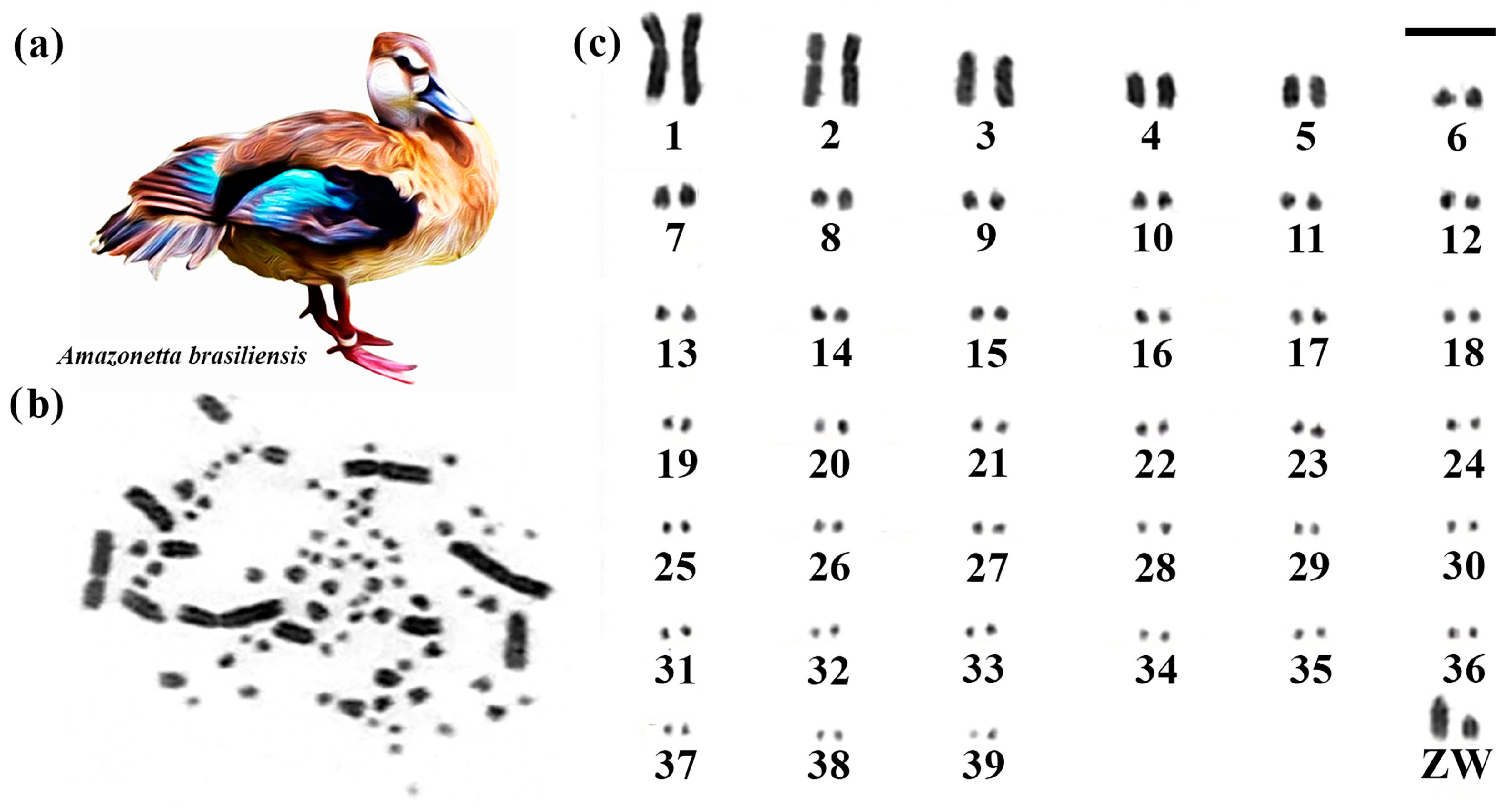

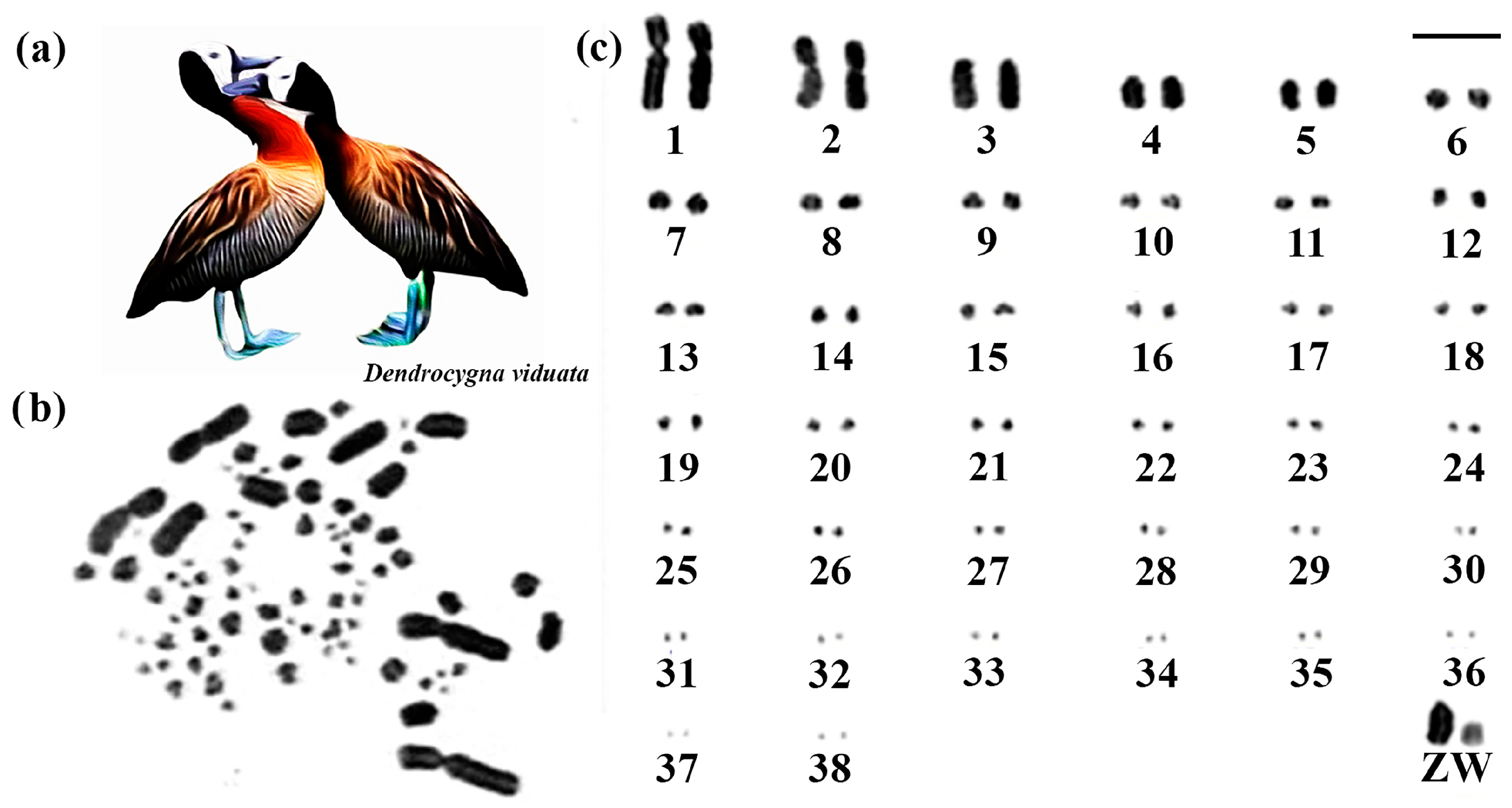
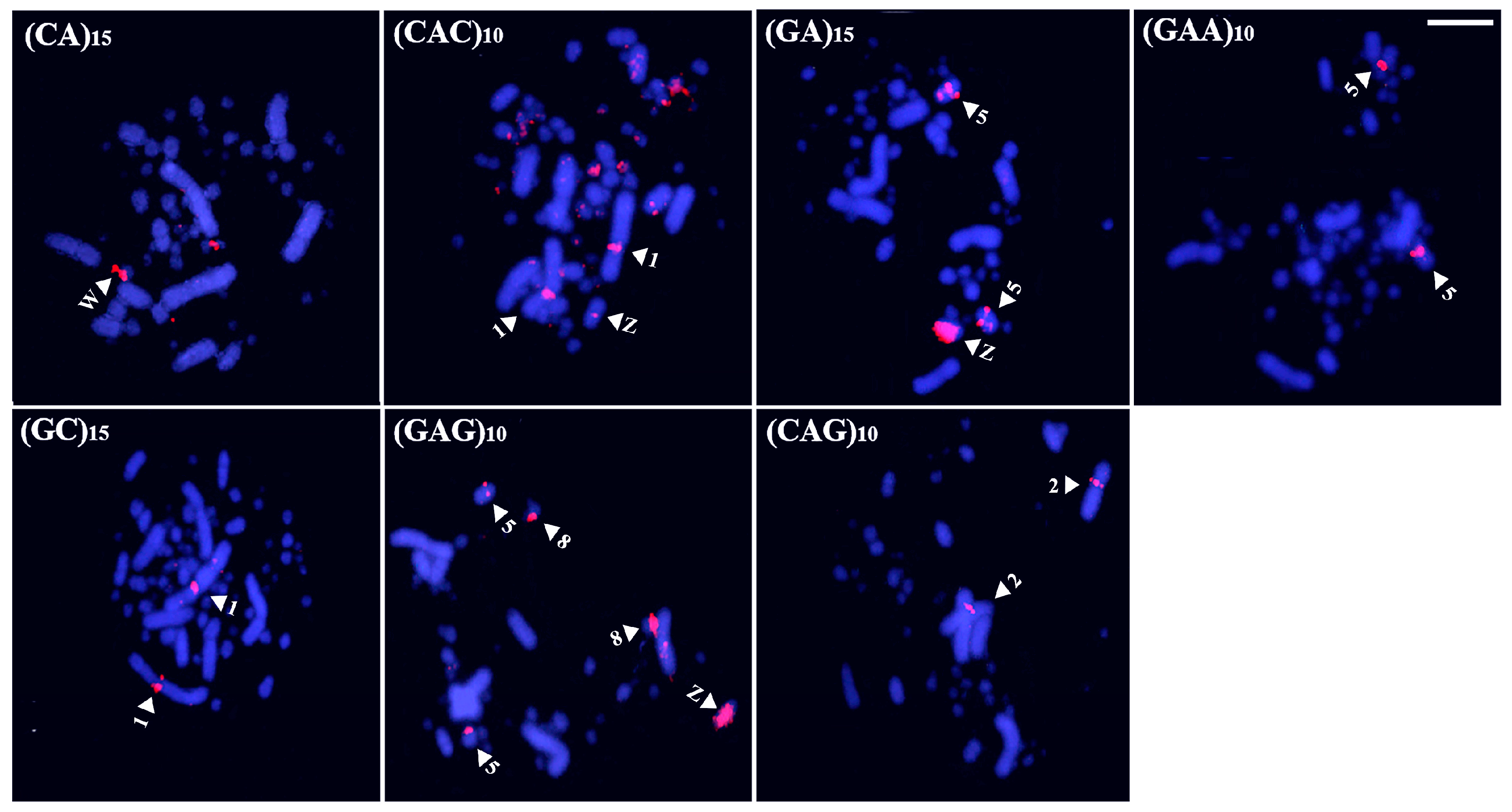
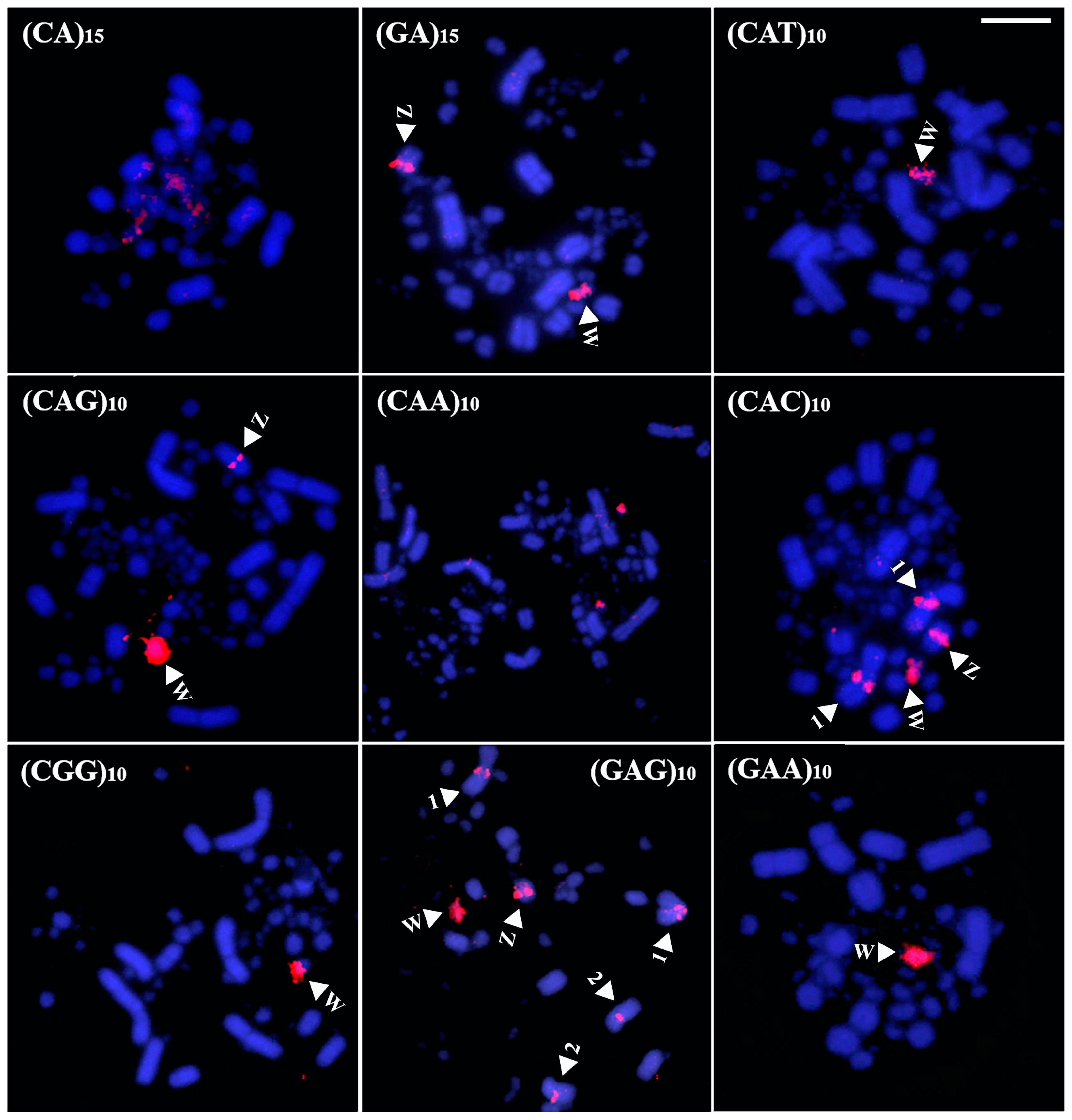
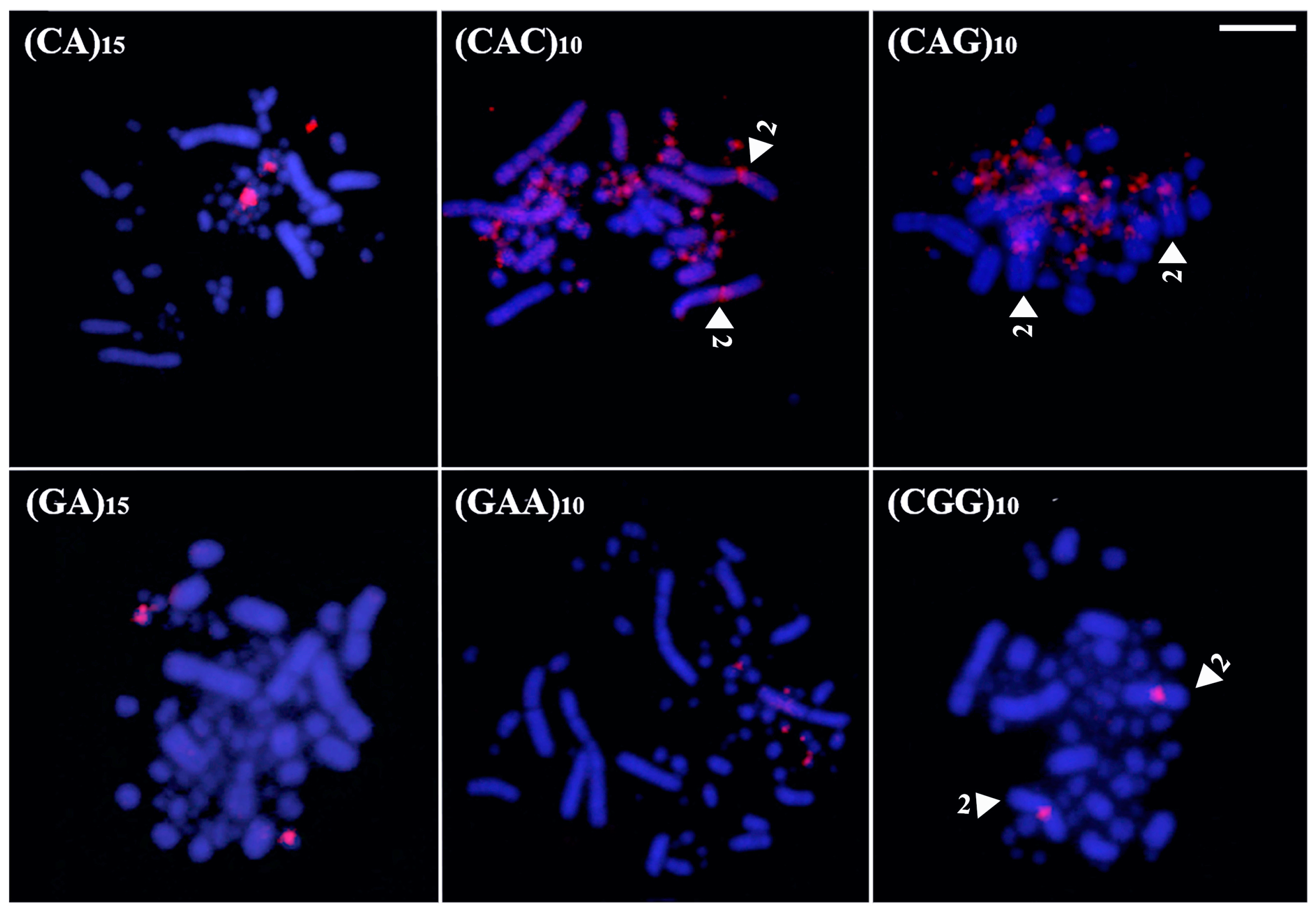
| Species | A. Brasiliensis (Brazilian Teal) | C. Coscoroba (Coscoroba Swan) | D. Viduata (White-Faced Whistling Duck) | |
|---|---|---|---|---|
| Microsatellites | ||||
| (CA)15 | Chromosome W | Microchromosomes | Microchromosomes | |
| (GA)15 | Pair 5 and chromosome Z | Chromosomes Z and W | Microchromosomes | |
| (GC)15 | Pair 1 | No signal | No signal | |
| (TA)15 | No signal | No signal | No signal | |
| (CAA)10 | No signal | Microchromosomes | No signal | |
| (CAC)10 | Pair 1, chromosome Z, and microchromoses | Pair 1, chromosomes Z and W | Pair 2 and microchromosomes | |
| (CAG)10 | Pair 2 (centromeric region) | Chromosomes Z and W | Pair 2 and microchromosomes | |
| (CAT)10 | No signal | Chromosome W | No signal | |
| (CGG)10 | No signal | Chromosome W | Pair 2 | |
| (GAA)10 | Pair 5 | Chromosome W | Microchromosomes | |
| (GAG)10 | Pair 5 and chromosome Z | Pairs 1, 2, and chromosomes Z and W | No signal | |
Disclaimer/Publisher’s Note: The statements, opinions and data contained in all publications are solely those of the individual author(s) and contributor(s) and not of MDPI and/or the editor(s). MDPI and/or the editor(s) disclaim responsibility for any injury to people or property resulting from any ideas, methods, instructions or products referred to in the content. |
© 2025 by the authors. Licensee MDPI, Basel, Switzerland. This article is an open access article distributed under the terms and conditions of the Creative Commons Attribution (CC BY) license (https://creativecommons.org/licenses/by/4.0/).
Share and Cite
Campos, P.S.B.; Rodrigues, B.S.; Gomes, A.J.B.; Corrêa de Sousa, R.P.; de Oliveira, E.H.C. Evolutionary Inferences on the Chromosomal Diversity of Anseriformes (Neognathae; Galloanseres) by Microsatellite Mapping. Birds 2025, 6, 20. https://doi.org/10.3390/birds6020020
Campos PSB, Rodrigues BS, Gomes AJB, Corrêa de Sousa RP, de Oliveira EHC. Evolutionary Inferences on the Chromosomal Diversity of Anseriformes (Neognathae; Galloanseres) by Microsatellite Mapping. Birds. 2025; 6(2):20. https://doi.org/10.3390/birds6020020
Chicago/Turabian StyleCampos, Paula Sabrina Bronze, Benilson Silva Rodrigues, Anderson José Baia Gomes, Rodrigo Petry Corrêa de Sousa, and Edivaldo Herculano Corrêa de Oliveira. 2025. "Evolutionary Inferences on the Chromosomal Diversity of Anseriformes (Neognathae; Galloanseres) by Microsatellite Mapping" Birds 6, no. 2: 20. https://doi.org/10.3390/birds6020020
APA StyleCampos, P. S. B., Rodrigues, B. S., Gomes, A. J. B., Corrêa de Sousa, R. P., & de Oliveira, E. H. C. (2025). Evolutionary Inferences on the Chromosomal Diversity of Anseriformes (Neognathae; Galloanseres) by Microsatellite Mapping. Birds, 6(2), 20. https://doi.org/10.3390/birds6020020






